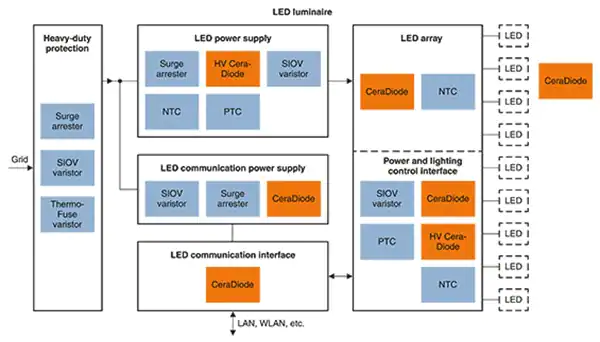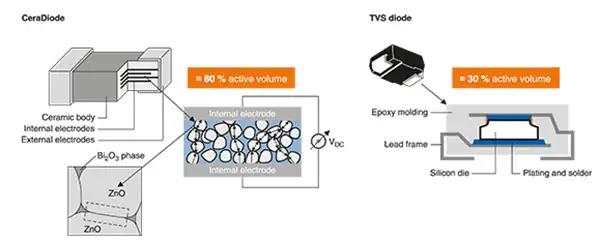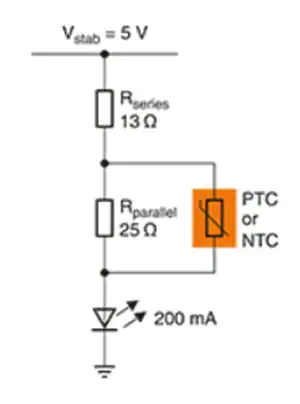Circuit Protection
Keeping the Lights On: ESD and Thermal Protection for LED Lighting Systems
The quality of LED lighting systems has been an issue since they were invented, which is one reason they were not adopted earlier as a household lighting system. In recent years, the installation of LED lights grew at an exponential rate globally, largely due to the promises of LED lighting: long life, energy efficiency, and cost savings. The U.S. Department of Energy’s website claims that LED light bulbs can last more than 25 times longer than traditional light bulbs. Although more than 50 million LED lights were installed in the U.S. in 2012, many LEDs failed within a few short months drawing consumers’ ire.
In 2013, the first LED bulb received the Energy Star certification due to advancements in LED lighting system technology. An Energy Star-certified LED lightbulb means that the system has met reliability, performance, as well as energy-saving requirements—a big shift in requirements.
How have engineers been able to meet the Energy Star certification requirements as well as overcome many of the obstacles that hindered LED systems in the past? With improvements in technology, protection devices became better able to defend against the major threats to LED lighting system’s performance and reliability. By determining and integrating the most suitable protection devices for the application requirements into the LED design, engineers were able to counteract threats—such as Electrostatic Discharge (ESD) and thermal issues—to LED systems. Let’s take a look at how the use of high-quality protection devices—in particular diodes, varistors, and thermistors—contribute to enhanced LED reliability, performance, energy efficiency, and cost-savings, and in turn, help LED lighting to deliver on its promises to outperform and outshine traditional light bulbs.
LED System Overview
An LED bulb—or more technically, a luminaire—is made up of three basic subsystems: an LED power supply, a power-input connection to the grid, and an LED engine. The LED engine can be further broken down into LED arrays, LED drivers, and control units.
Over the past several years, smart LED luminaires have gained popularity due to features including remote control and maintenance. Because of this, a fourth subsystem—communication power supplies and interfaces—is often integrated into the luminaires. The design allows customers to deploy smart-networked lighting systems that maximize the efficiency and quality of lighting as well as track the status of each luminaire for maintenance purposes.
Factors Affecting LED Quality
Several factors can affect solid-state lighting, including stress, packaging-related, and component-related issues. Companies who design and manufacture LED lighting systems must take into account these factors. There are five key threats that affect the reliability of LED lighting systems:
- Electrostatic discharge (ESD) events, including lightning
- Transient overcurrent and surges
- Current and voltage spikes during hot swapping
- Reverse voltage effects
- Thermal issues such as operating at high temperatures for long periods
For LED lighting systems to be reliable, all of the components and subsystems must be protected sufficiently against these dangers during assembly, maintenance, and operation.
LED Protection Solutions
As the LED lighting system technology matured, engineers began integrating high-quality protection devices into their LED designs to prevent high- and low-energy surges, ESD events, and thermal stress from adversely affecting LED arrays, their power supplies, and control circuits. The integration of these protection devices resulted in LED lighting systems with higher reliability, lower maintenance costs, and a longer product lifetime.
By assessing the application requirements of the LED design, engineers can determine the most suitable protection devices to use to enhance LED performance and reliability. Figure 1 shows an example of how engineers can use diodes, varistors, and thermistors in the system architecture of an LED luminaire.

Figure 1: A basic LED lighting system architecture complete with ESD and heat protection devices. (Source: TDK Corporation)
Diodes and Varistors
Diodes and voltage-dependent resistors, also known as varistors, are developed to meet unique design challenges for many applications. These solutions are often ruggedized, have a much smaller footprint, and protect against certain types of surge currents.
The EPCOS CeraDiode® from TDK Corporation is designed to absorb high energy at a better rate than Transient-Voltage Suppression (TVS) diodes and has a smaller footprint (Figure 2). Eighty percent of the component volume of this product is used to absorb the energy ESD events, which is superior to the thirty percent of standard TVS diodes—and it has the same performance. Because of this, non-standard parts should be considered if they can help minimize space requirements and provide an identical or improved performance. This is particularly important in applications that require miniaturization, reliable protection, and high performance.

Figure 2: An example of a specialized or non-standard component used to protect against ESD events. (Source: TDK Corporation)
Thermistors
Thermistors, or thermally sensitive resistors, are highly accurate sensors for measuring temperature. There are two types of thermistors:
- Negative Temperature Coefficient Thermistors (NTC)
- Positive Temperature Coefficient Thermistors (PTC)
The difference between the two types of thermistors is that an NTC thermistor’s electrical resistance decreases as temperature increases, whereas a PTC thermistor’s electrical resistance increases as temperature increases.
Available in surface mounted design (SMD) packages, NTC thermistors protect the LED arrays against overheating and help control their temperature profile at peak lumen efficiency. NTC thermistors provide thermal protection by automatically adjusting the current to the LEDs. Together with intelligent circuits, they enable an effective control system (Figure 3).

Figure 3: Diagram of a temperature-compensated LED driver without an IC. (Source: TDK Corporation)
In temperature-compensated LED driver designs without integrated circuits, PTC thermistors can reduce the high temperatures of the forward current by placing them in series to the LED. In such a design, most of the LED current flows via the PTC thermistors.
LED Design
Engineers can guard against factors that adversely affect LED reliability by integrating protection devices into their design. Here are a few examples of how integrating protection devices into the LED design can counteract the major threats to LED lighting systems.
ESD
LED engines can consist of hundreds of LEDs that are normally series-connected strings, parallel-connected strings, or a combination of both. If one LED fails in a series-connected string, the entire series will fail. This is because LEDs in a series-connected string can cause an antenna effect making the array more sensitive to ESD events. Multilayer varistors can protect against such events.
Bidirectional Protection Against ESD and Transient Disturbances
Multilayer varistors are an excellent option for bidirectional protection against ESD and transient disturbances. A typical TVS diode is inherently unidirectional, making it necessary to design in two diodes. However, varistors provide bidirectional protection as a single component with the same protection. In this case, varistors will provide a size and cost advantage to the design.
High-energy Surges
Engineers realized they needed a way to prevent ESD events and high-energy surges from affecting the luminaire. These surges can cause both immediate failures—often at a junction—and an increased rate of degradation caused by latent damage. Each of the four subsystems can be exposed to events that cause this kind of damage.
Varistors have long been a solution of choice for overvoltage protection. This is because the electrical resistance varies with the applied voltage. Engineers should select varistors that are designed to hold up to the conditions of the end application.
Take for example the protection of power supplies. Metal oxide varistors are especially well-suited to protect the power supplies of LED lighting systems from larger energetic surges. The design may specify varistors that feature a compact design, or that provide protection against big ESD events such as lightning strikes. Due to the harsh nature of the elements and cost of maintenance, LED lighting systems designed for streetlights should meet both ANSI/IEEE C62.41.2 and the DOE MSSLC Model Specification for LED roadway luminaires. In these cases, surge arresters combined with varistors offer a space-saving integrated solution with exceptional performance.
In the power input connection, a single package consisting of a disk varistor connected in series with a thermally coupled fuse is best suited to provide the protection required. In this case, if the varistor overheats, the thermal fuse—which is encapsulated in a plastic housing—disconnects the varistor from the power circuit preventing fire, safely shutting down the system.
Low-energy and ESD Discharges
TVS diodes have been used for many years to protect circuits from low-voltage ESD events below 25J (Joules). However, multilayer varistors offer significant advantages over traditional TVS diodes. These include many miniature sizes and insertion heights, more dependable performance, faster response times, and better overall operation across wide temperature ranges. Engineers can use TVS diodes to meet the absorption requirements relating to the component size.
Current and Voltage Spikes
Networks are often reconfigured, moved, replaced, and taken offline for maintenance. Consequently, hot swapping is a common practice, and hot swapping can cause ESD events and low-voltage spikes. Multilayer varistors or TVS diodes that have extremely low-parasitic capacitance are preferred for the ESD protection of data lines for the control of luminaires. Such diodes will ensure that the devices would remain fully functional for their specified lifetimes.
Thermal Stress
In most cases, sudden failures in LED lighting systems are caused by thermal stresses. The temperature of LEDs must be controlled within narrow limits to deliver an uninterrupted luminance. Thermistors provide an accurate and cost-effective way of measuring temperature.
Keeping the Lights On
As LED technology continues to mature, design engineers can increasingly prevent the high- and low-energy surges and ESD events that affect LED reliability by simply determining the most suitable protection devices that are required by the application. In addition, they can also plan for the proper temperature protection needed in their applications, thereby keeping the lights on in a very literal way.
As a result, they will help deliver on the U.S. Department of Energy’s claims that LEDs should last 25 times longer than traditional lighting systems.